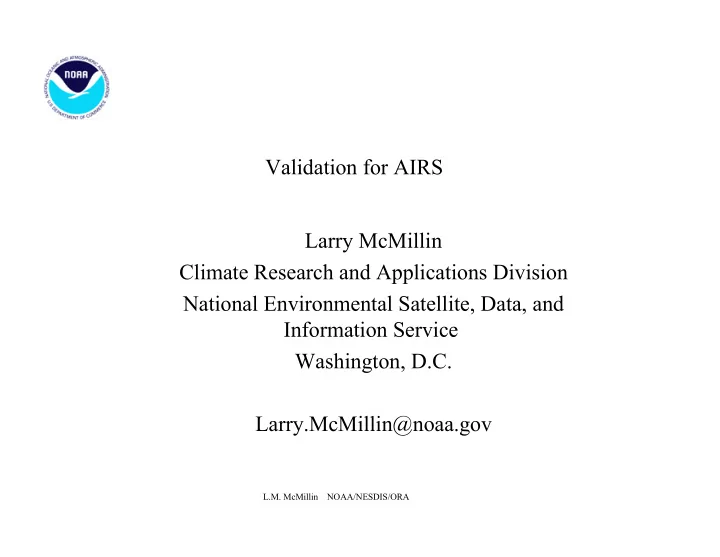

Validation for AIRS Larry McMillin Climate Research and Applications Division National Environmental Satellite, Data, and Information Service Washington, D.C. Larry.McMillin@noaa.gov L.M. McMillin NOAA/NESDIS/ORA
Validation Plans • A trial version is set up on a website • Orbit-net.nesdis.noaa.gov/crad/ipo • Capabilities – View granules from team exercise - Uses IDL from Ed Olsen – View ACARS reports – View monthly statistics TOVS up through NOAA 14 – View data as a function of time, angle etc. – View the HDF format specification L.M. McMillin NOAA/NESDIS/ORA
Data • Current – Radiosondes – Buoys – Aircraft – Hourly surface observations – Other satellites – Forecasts/analysis • Planned – GPS moisture – Ozone – Upper atmospheric temperatures – ARM data L.M. McMillin NOAA/NESDIS/ORA
Data - continued • Moisture – Current upper atmospheric measurements should be more accurate than radiosondes even though the same sensor is used due to compression/heating – Current aircraft moisture may be difficult • Data are available • Uses the Viasalla sensor • Ages with time and need calibration • Adjusted data available from NCAR, but online data has issues – Starting to deploy an advanced sensor • Better upper atmospheric measurements • Uses a small absorption cell L.M. McMillin NOAA/NESDIS/ORA
Radiosonde files • Radiosonde data • Hourly surface temperatures • SST if available • AIRS data • AIRS retrievals – Bias adjusted – Unadjusted • Aircraft reports L.M. McMillin NOAA/NESDIS/ORA
Format • Truth points to satellite data • Use existing formats as much as possible – Match the RTM for retrievals – Use Mitch’s for satellite radiances • Putting Dec. 10 data in the format • Exchange with Larrabee L.M. McMillin NOAA/NESDIS/ORA
Data exchanges • Get initial data and locations from Mitch • Get NCEP PREPQC • Extract matches • Get match locations from Mitch • Get team retrieval information from JPL – Retrieval with bias removed – Retrieval without bias removal • Combine all information • Send match file to JPL • Send match file to UMBC • Add data such as ozone and rocketsondes as available L.M. McMillin NOAA/NESDIS/ORA
Approach • Online display of frequent analysis • Considering – download of small match sets • Downloads to selected sites – UMBC – Goddard – JPL L.M. McMillin NOAA/NESDIS/ORA
Capabilities • Intercompare satellites • Error as a function of – time – time difference defined as (satelite - radiosonde) – collocation distance between the satellite and the radiosonde • equator or pole • east or west – solar zenith angle – scan angle – level – radiosonde type – location L.M. McMillin NOAA/NESDIS/ORA
Mystery for the Moment • Ship radiosondes are in the NESDIS files but not JPL – The next two slides show the locations of the raobs in the HIRS operational match file • One shows ocean locations • One shows the land locations L.M. McMillin NOAA/NESDIS/ORA
L.M. McMillin NOAA/NESDIS/ORA
L.M. McMillin NOAA/NESDIS/ORA
Slide Description • The next 2 slides show the match between calculated and observed radiances L.M. McMillin NOAA/NESDIS/ORA
L.M. McMillin NOAA/NESDIS/ORA
L.M. McMillin NOAA/NESDIS/ORA
Slide Description • The next two slides show the aircraft reports for – The European carriers – The US carriers L.M. McMillin NOAA/NESDIS/ORA
L.M. McMillin NOAA/NESDIS/ORA
L.M. McMillin NOAA/NESDIS/ORA
L.M. McMillin NOAA/NESDIS/ORA
L.M. McMillin NOAA/NESDIS/ORA
Slide Description • The next slide shows accuracy as a function of time • NOAA 15 • Note the typical increase in accuracy in the NH summer L.M. McMillin NOAA/NESDIS/ORA
L.M. McMillin NOAA/NESDIS/ORA
L.M. McMillin NOAA/NESDIS/ORA
L.M. McMillin NOAA/NESDIS/ORA
Lessons Learned • Samples of validation studies – Error increases with time over land – Time difference is not large factor over water – There is an East - west gradient due to time of day over land – There is an equator to pole ward bias due to the temperature gradient • Note – this is not a true error – Retrievals are colder at night over land L.M. McMillin NOAA/NESDIS/ORA
Plans • Run with HIRS • Complete the satellite data specification • Add capabilities L.M. McMillin NOAA/NESDIS/ORA
Recommend
More recommend